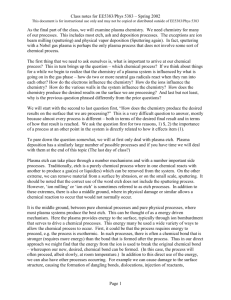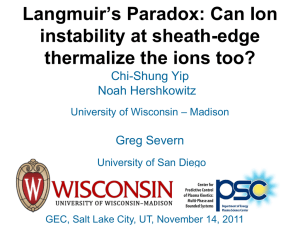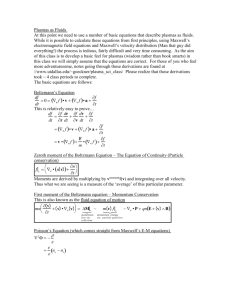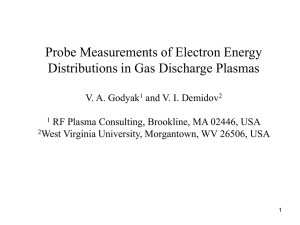Ion Matrix Sheath
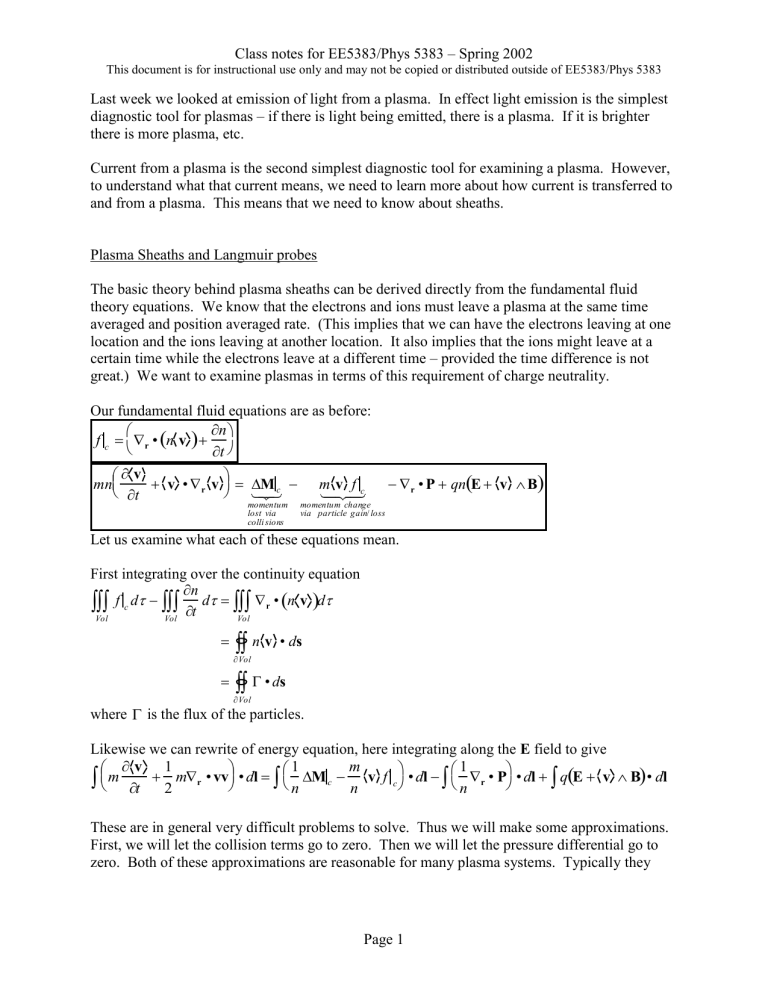
Class notes for EE5383/Phys 5383 – Spring 2002
This document is for instructional use only and may not be copied or distributed outside of EE5383/Phys 5383
Last week we looked at emission of light from a plasma. In effect light emission is the simplest diagnostic tool for plasmas – if there is light being emitted, there is a plasma. If it is brighter there is more plasma, etc.
Current from a plasma is the second simplest diagnostic tool for examining a plasma. However, to understand what that current means, we need to learn more about how current is transferred to and from a plasma. This means that we need to know about sheaths.
Plasma Sheaths and Langmuir probes
The basic theory behind plasma sheaths can be derived directly from the fundamental fluid theory equations. We know that the electrons and ions must leave a plasma at the same time averaged and position averaged rate. (This implies that we can have the electrons leaving at one location and the ions leaving at another location. It also implies that the ions might leave at a certain time while the electrons leave at a different time – provided the time difference is not great.) We want to examine plasmas in terms of this requirement of charge neutrality.
Our fundamental fluid equations are as before: f c
r
•
n
t
mn
v
t
v • r v
M c momentum lost via colli sions
m v f c momentum change via particle gain / loss
r
• P
v
B
Let us examine what each of these equations mean.
First integrating over the continuity equation
Vol f c d
Vol
n
t d
Vol
r
•
n v
d
n v
•
ds
Vol
•
ds
Vol where is the flux of the particles.
Likewise we can rewrite of energy equation, here integrating along the E field to give
m
v
t
1
2 m
r
• vv
• dl
1 n
M c
m n
v f c
• dl
1 n
r
• P
• dl
v
B
• dl
These are in general very difficult problems to solve. Thus we will make some approximations.
First, we will let the collision terms go to zero. Then we will let the pressure differential go to zero. Both of these approximations are reasonable for many plasma systems. Typically they
Page 1
Class notes for EE5383/Phys 5383 – Spring 2002
This document is for instructional use only and may not be copied or distributed outside of EE5383/Phys 5383 have very thin sheaths compared to the mean-free path and are in low-pressure systems. Thus our equations simplify to:
V ol
n
t d
V ol
•
ds
m
v
t
1
2 m
r
• vv
•
dl
v
B
•
dl
We can further simplify our model by assuming time independence and no magnetic field. This eliminates a lot of real sheaths that we might run across but it makes the model understandable.
Thus, we are dealing with the following set of equations
•
ds
0
Vol
nv
const
1
2 m
r
• vv
• dl
qE • dl
q
• dl
1 m
v
2 q
2
We will use these equations to give us the ion density and velocity at different points in the sheath. (The above equations are general and we had not applied them to any species.) The only thing that we need to know is what is the potential as a function of position. Still, we can determine the velocity and the density as a function of the potential. Thus we have n i
v is v i n is
1
2 m i v i
2
1
2 m i v is
2
e
s
where ‘s’ stands for the value at the sheath edge. Combining the equations gives
1
2 m i
n is n i v is
2
1
2 m i v is
2
e
s
m i n is
2 v is
2 n i
2
m i v is
2
2 e
s
n is
n i
1
2 e m i v 2 is
s
1/ 2 or n i
n is
1
2 e m i v 2 is
s
1/ 2
We now have one equation and two unknowns, the potential in the sheath and velocity of the ions at the sheath edge. We can get one of these unknowns by using Poisson’s equation to get the potential.
Page 2
Class notes for EE5383/Phys 5383 – Spring 2002
This document is for instructional use only and may not be copied or distributed outside of EE5383/Phys 5383
2
e n e
n i
Again we are missing a piece of the puzzle, but now it is the electron density. There are a couple of readily useful options. 1) There are no electrons in the sheath. 2) The election density is set by Boltzmann’s equation. The second option is the one used most commonly, while the first is appropriate only for very special situations.
Initially, let us assume that the electrons follow Boltzmann’s equation. Thus, n e
n
0 e where n
0 e
/ kT e
is the electron density at the point at which the potential is zero. Or we can write this in terms of the potential at the sheath edge and get n e
n es e e
s
/ kT e
Review:
At this point, we have four fundamental equations which describe what goes on inside the sheath,
Energy conservation:
1
2 m i v i
2 1
2 m i v
2 is
e
s
Flux conservation: n i
Poisson’s Equation:
2 v is v i n is
Boltzmann’s Distribution: n e
e n e
n i
n es e e
s
/ kT e
Note that all values are relative to the values at the sheath edge. We will now use these equations to determine what exactly is the requirement for a sheath edge!
Taking our equation for the ion density and plugging into Poisson’s equation to give
2
2 e
e
n es e
n es e
e
s
e
/ kT e
/ kT e
n is
n is
1
1
e is
1
2 m i
e v 2 is
1/ 2
s
1/ 2
. where s
0
and is
1
2 m i v is
2 .
This equation can be integrated once analytically. This is done in the following way. First multiply by . This gives
e
n es e e
/ kt n is
1
e is
1/ 2
Now integrate over d l
Page 3
Class notes for EE5383/Phys 5383 – Spring 2002
This document is for instructional use only and may not be copied or distributed outside of EE5383/Phys 5383
0
0 l l
1
2
• dl
2 •
dl
0
0 l
l
e e
n es
n es e e
/ kt e kT e e e e
/ kt
n is
1
2 n is
is e e
is
1/ 2
• dl
1
e
is
1/ 2
•
dl where 0 is the sheath edge and l is a position in the sheath. Now, d
dl
so that we can use the
first principle of calculus and get
0 l
1
2 d
dl
2 •
dl
0 l
e d
dl
n es kT e e e e
/ kT e
2 n is
is e
1
e
1/ 2
is
•
dl
1
2
1
2
2 l l
0
e
n es kT e e e
/ kT e e
2 n is
is e
1
e
1/ 2
is
l l
0
2
0
2
e
n es kT e e
e e
/ kT e
e
0 e
/ kT e
2 n is
is e
1
e
1/ 2
is
1
0 e
is
1/2
1
2
2 e
n es kT e
e e
/ kT e e
1
2 n is
is e
1
e
1/ 2
is
1
1
2
2
0
0
2
e
n es kT e e
e e
/ kT e
e e
0
/ kT e
2 n is
is e
1
e
1/ 2
is
1
0 e
is
1/2
or
2 e
n es kT e e
e e
/ kT e
1
2 n is
is e
1
e
1/ 2
is
1
Bohm Presheath Requirement
There is no known way to further analytically integrate this equation. However we can still tell that the term inside the square root cannot be negative – or else the potential is imaginary. We can learn something from this requirement.
n es kT e e
e e
/ kT e
1
2 n is
e is
1
e
is
1/ 2
1
0
For small potentials, we can expand the exponential term to get
Page 4
Class notes for EE5383/Phys 5383 – Spring 2002
This document is for instructional use only and may not be copied or distributed outside of EE5383/Phys 5383
n es kT e e
1
e
kT e
1
2 n is
is e
1
e
is
1/ 2
n es
2 n is
e is
1
e
is
1/ 2
1
0
Further we can expand the square root term to get
n es
2 n is
e is
1
1
2 e
is
1
0
1
0
n es
2 n is
is e
1
2
n es
n is
0 e
is
0 n es
n is
remember that
0!
This means that the electron density must be less than the ion density but not by much. This is not surprising as we have already said that the sheath occurs because the electrons would otherwise leave faster than the ions. This makes it such that electron density is slightly smaller than the ion density. Now, if we assume that the electron and ion densities are approximately the same, so that n es
n is
n s
as we typically assume in the plasma, we can now go back and examine the right hand side of our inequality again.
n s kT e e
e e
/ kT e
1
2 n s
e is
1
e
is
1/ 2
1
0
kT e e
e e
/ kT e
1
2
is e
1
e
1/ 2
is
1
0
Now we will expand the equation to the second order so that
0
kT e e
1
e
kT e
e
2
2k
2
2
T e
2
1
2
e is
1
e
2
is
e
2
8
2
2 is
1
0
e
2
2kT e
e
4
2 is
0
e
2
2kT e l
e
4
2 is l
kT e
2
is
kT e i
1/2 v is
v
B
M
ion acoustic / Bohm velocity
This is known as the Bohm Sheath criteria. In effect, it says that the ions have to be traveling at the ion acoustic velocity before they enter the sheath. This makes sense as the if the velocities were zero at the edge of the sheath, then the flux of the ions into the sheath would be zero (unless
Page 5
Class notes for EE5383/Phys 5383 – Spring 2002
This document is for instructional use only and may not be copied or distributed outside of EE5383/Phys 5383 the density was infinite!). This means that we have to have a region in which the ions are accelerated from 0 to the acoustic velocity. This region is known as the ‘presheath.’
What does this mean? First to accelerate the ions to the Bohm velocity we need to have a potential drop such that the kinetic energy increases. At first we will assume that energy is conserved, e.g ignore collisions. Thus, we find that
1
q
2 m
v
2
1
2
M i
v
2
B
v
2
0 plasma
q
B
plasma
1
2
M i kT e
M i
q
B q
B
1 kT e
2
Likewise we know that we can determine the electron density at the edge of the sheath from
Boltzmann’s equation. n s
n plasma e
q
B kT e
n plasma e
1 2
0.61
n plasma
The above discussion implies that there has to be some sort of presheath region which accelerates the ions from zero to the Bohm velocity. We can get some handle on what the presheath looks like if we assume a few simple things. First, that the ion and electron densities are equal throughout the presheath. Second, that the electron density follows Boltzmann’s equation. Third and final, that the ions enter the presheath at zero velocity and leave on the other side at the Bohm velocity. Thus we have the following picture.
Page 6
Class notes for EE5383/Phys 5383 – Spring 2002
This document is for instructional use only and may not be copied or distributed outside of EE5383/Phys 5383
n
n
0
n i
n e
, v
0
0 n i
n e
n
0 e e
/ kT e v
v
B
kT e
M i plasma presheath sheath
X or r
To understand the presheath, we need to look at the ion flux through the presheath. This is simply
i
n i v i
.
Taking the derivative of both sides gives
• i
n i
•
•
v i
• now dividing through by the flux, we get
1
i
• i
v
1 i
•
i
1 n i
i
.
Plugging in Boltzmann’s equation gives
1
i
• i
1 v i
•
1 n i
1 v i
•
i
1 n
0 e e
/ kT e
n
0 e e
/ kT e
1 v i
•
1 n
0 e q
/ kT e n
0 e q
/ kT e e kT e
1
•
v i
What does this mean? e kT e
We have the ion flux in terms of the ion velocity and the potential. We would like to determine the flux in terms of only one parameter. If we make the assumption that energy is conserved then we can replace the velocity with the potential. Obviously there are ways in which energy can also be added or subtracted! (While other examples are doable, the only simple example is to assume conservation of energy.)
1
If the energy is conserved than m
v
2 e
. This implies for our case that
2
Page 7
Class notes for EE5383/Phys 5383 – Spring 2002
This document is for instructional use only and may not be copied or distributed outside of EE5383/Phys 5383
1
M i v
2
2 thus
e
or v
v i
2 e
M i
2 e
M i
2 e
M i
1
2
1
2
2 e
M i
1
2 e
1
M i
1
2 v
1
1 v i
v i
1
2
1
and at the sheath edge
1
M i kT e
M i
e
2 kT e
1
2 e
Plugging this into our flux equation we find
1
i
• i
1 v i
•
e kT e
1
2
1 e kT e
1
2
2 e kT e
e kT e
at the sheath edge
= 0
This implies that
• i
= 0 in the presheath if the energy is conserved. Other solutions typically have to be found via computer simulations.
Classified Sheaths
There are a few important standard sheaths. These are sheaths to a floating wall, sheaths to a grounded wall and sheaths to a driven wall. We will start with the sheath potential at a floating wall.
Page 8
Class notes for EE5383/Phys 5383 – Spring 2002
This document is for instructional use only and may not be copied or distributed outside of EE5383/Phys 5383
Floating sheaths
If a wall or other object is inserted into a plasma and there is no way for the charge to drain from the surface, we have a situation in which the wall is electrically floating. This gives rise to a
‘floating sheath’. In this case, the object will charge up until the flux of electrons and ions match. Thus to find floating potential of the object we simply need to determine the potential at which the fluxes match.
The flux of ions to the wall is given by
i
= const
= n s v
B
n s kT e
M i
This flux is matched by the flux of electrons to the surface. The electron flux is those electron headed toward the surface which also have enough energy to overcome the potential. Thus,
e
=
v min v x
dv x dv y dv z where v mi n
2 e
w m e is set by energy requirements
Thus
e
n e
m e
2
kT e
3/ 2
2 e
w m e v x exp
m e
v
2 x
v y
2
2 kT e
v z
2
dv x dv y dv z
n e
m e
2
kT e
1/ 2
2 e
w m e v x exp
m e
2
kT e
dv x
n e
1
2
2 kT e
m e
1/ 2
2 e
w m e exp
m
2 e kT v e
2
d
m e v
2 kT e
2 x
n e
1
2
2 kT e
m e
1/ 2
2 e
w m e exp
n e
kT e
2
m e
1/ 2 exp
e
w kT e
n e
1
4 average speed v exp
e
w kT e
Now the flux of the ions and the electrons must come into balance so that
Page 9
Class notes for EE5383/Phys 5383 – Spring 2002
This document is for instructional use only and may not be copied or distributed outside of EE5383/Phys 5383 n e
kT e
2
m e
1/ 2 exp
e
w kT e
n s kT e
M i
n e kT e
M i
w
kT e e ln
2
m e
M i
Grounded/driven Sheath
In this case the electrode is electrically connected such that we can add or subtract any necessary charge to provide balance. As before the flux of ions to the surface is
i
= n i
v i
const
(Note that while I am doing this for flux, you really want to do this for current. The distinction is that the ions might be doubly – or greater – charged. Thus the ion flux might not be the same as the electron current/electron charge. You really need to know how much charge you are carrying to the surface.)
To keep things as simple as possible, we will assume that the energy is conserved. Thus
1
M i
v
2 e
.
2
If we assume further that the initial kinetic energy and potential is zero – hence ignore the presheath – we find
1
M i
v
2 v
B
2
e
S
2
or v
v
B
2
2 e
S
M i
but v
B
2 kT e
M i
S thus
1
2 kT e e v
kT e
2 e
M i
M i kT e
M i
2 e
M i and
Page 10
Class notes for EE5383/Phys 5383 – Spring 2002
This document is for instructional use only and may not be copied or distributed outside of EE5383/Phys 5383
i
= n i
v i
const
n i
2 e
M i
n i
i
2 e
M i
This means that in the sheath, the ion density can be determined if we know the potential. We can find the potential from Poisson’s equation
2
n e
n
0 e e
we find
/ kT e
e n e
n i
Plugging in our ion density variation electron density from the Boltzmann’s equation
2
e
n
0 e e
/ kT e
i
2 e
M i
As we did before, we can integrate this by multiplying by and then integrating. Thus
2
e
n
0 e e
/ kT e
i
M i
2 e
0 r
2
• dr
e
0 r
n
0 e e
/ kT e
i
0 r 1
2
2 •
dr
e
0 r
n
0 kT e e
e e
/ kT e
M i
2 e
i
2
• dr
M i
2 e
•
dr
1
2
2 r
0
e
n
0 kT e e
e e
/ kT e
i
2
M i
2 e
r
0
e
kT e e n e
i
Now assume the following. 1)
2 r
M i
0
2 e
0
r
0
, 2) r
0
0
, AND 3) n e
0
.
The first two assumptions are reasonable, while the third assumption is an important approximation that allows us to obtain an approximate analytic solution known as Child’s Law. With these assumptions we find
Page 11
Class notes for EE5383/Phys 5383 – Spring 2002
This document is for instructional use only and may not be copied or distributed outside of EE5383/Phys 5383
1
2
2 i e
2
M i
2 e
2
e
i
1/ 2
M i
2 e
1/ 4
1/ 4
2
e
i
1/ 2
Integrating again
0 r
1/ 4
dr
M
2 e i
1/ 4
0 r
2
e
i
1/ 2
M i
2 e
1/ 4
dr
0 r 4
3
3/ 4
dr
2
e
i
1/ 2
M i
2 e
1/ 4
0 r
dr
4
3
3/ 4
2
e
i
1/ 2
M i
2 e
1/ 4 r
3/ 4
3
2
e
i
1/ 2
M i
2 e
1/ 4 r
3
2
eM
2
i
i
2
2
1/ 4
r
This is known as the Child’s Law sheath – in a form this is a bit more general than what is found in Lieberman. It is the only known analytic description, albeit an approximate solution, to the sheath equation.
Ion Matrix Sheath
The ion matrix sheath occurs when the potential on an object changes very rapidly. In this case, the electric field change is such that the electrons leave the immediate region while the ions remain fixed for a small instance. (The heavy ions cannot respond as fast as the light electrons.)
Then there is an electric field that occurs through a uniform distribution of ions. How thick is such a sheath and what is the potential structure? From Poisson’s equation we know:
Page 12
Class notes for EE5383/Phys 5383 – Spring 2002
This document is for instructional use only and may not be copied or distributed outside of EE5383/Phys 5383
2 e
0 n e
const
n
0
n i
e
n
0
const
integrating once gives
e
n
0 r
E
integrating again gives
2 e
n
0 r 2
inverting r
2
en
0
- Thus at the wall
S wall
W al l
2
en
0
Debye
2
W al l , kT e
Debye
kT e en
0
Langmuir Probes
At this point, we can begin to look at how we can use this information to examine the plasma.
Langmuir probes were invented, along with much of the basis of plasma science, by Irving
Langmuir is the 1920’s. Langmuir probes are small metal (or otherwise conducting) probes that are inserted into the plasma and which can be set to a range of biases. For processing and space plasmas, these probes can generally be positioned any where within the discharge. For thermal or fusion plasmas, because of the intense heat load, Langmuir probes can only be used at the edge of the discharge. Fortunately this is OK with us as we are only studying in process and space plasmas in this class.
At first blush, Langmuir probes are very simple to construct, very simple to use and very simple to understand. Unfortunately, none of these are entirely true. However, we can learn a significant amount about Langmuir probes by examining a simple model of the probe. To do this, we need to first look at how a Langmuir probe might be set up for a simple experiment.
Page 13
Class notes for EE5383/Phys 5383 – Spring 2002
This document is for instructional use only and may not be copied or distributed outside of EE5383/Phys 5383
Vacuu m
System
Probe
Tip
Insu lating cove r
Powe r supp ly
Plasma
Volt meter
Ammeter
As can be seen from the picture, the probe tip is positioned in the plasma, through a insulating cover so that the probe interacts with the plasma in only the location of the tip. (We will see later that while this is the intension, this is not always reality.) A variable power supply is connected to the probe such that various biases can be applied to the probe tip. In addition, a voltmeter and an ammeter are connected to the circuit so that the bias to the tip and the current through the tip can be measured. (For the very simplest system, dc glow discharge, such an arrangement for the Langmuir probe is usually sufficient. For more complex discharges, e.g. pulsed or rf, the probe circuitry can be more complex. Again, we will discuss this below.)
To collect data with a Langmuir probe, one typically sweeps the bias with the power supply and measures the resultant current-voltage sweep. Typically one will find a trace that looks something like:
Page 14
Class notes for EE5383/Phys 5383 – Spring 2002
This document is for instructional use only and may not be copied or distributed outside of EE5383/Phys 5383
Plasma formation through thermi oni c and secondary electron emission
Electron satura tion current
Electron and ion current
Plasma potential
Plasma formation through seconda ry electron emission
Ion saturation current
Floating potential
(Typically one does not get into the dashed areas on the curve.)
At this point we need to develop a model of what is going on. If the probe is biased below the plasma potential, then we will draw ions to the probe tip. In addition, we will be able to collect that portion of the electron distribution which has enough kinetic energy to overcome the potential energy barrier produced by the probe bias. We will first deal with the ions. By the
Bohm Sheath criteria, the ions will enter the sheath at a velocity given by the potential drop across the presheath region. Namely v n i
kT e
M
1/2 i
In addition, the ions will be at the same density as the electrons at the sheath boundary, namely:
n e
0.6n
0
Assuming that flux is conserved in the sheath, we find that the ion current (q*flux) density is
J i
en i v i
e0.6n
0
kT e
M
1/2 i
(noting that this assumes that the ions are singularly charged.)
At this point, we need to examine the electron current to the probe tip. Here the current is not so trivial to calculate – but we have done so in for the current to a floating probe. Carrying out the same derivation as above – but this time including the charge, we find
Page 15
Class notes for EE5383/Phys 5383 – Spring 2002
This document is for instructional use only and may not be copied or distributed outside of EE5383/Phys 5383
J e
e
e
en e
m e
2
kT e
3/2
en e
m e
2
kT e
1/2
2e
P m e
2 e
P v x exp
m e
v
2 x
v
2 y
2kT e m e v x exp
m e
2kT
e
dv x
en e
1
2
2kT e
m e
1/2
2e
P m e exp
m e
2kT e
d
m
e v
2 x
2kT e
v
2 z
dv x dv y dv z
en e
1
2
2kT e
m e
1/2
2e
P m e exp
d U
en e
kT e
2
m e
1/2
exp
e
P kT e
en e
1
4 av erage sp eed v exp
e
P kT e
where
P
probe
plasma .
Now the total current to the probe, I
P
, is the sum of the two currents times the collection area, A
P
,
I
P
A
P
J e
J i
.
This model gives a curve that looks like
Page 16
Class notes for EE5383/Phys 5383 – Spring 2002
This document is for instructional use only and may not be copied or distributed outside of EE5383/Phys 5383
Electron satura tion current
Electron and ion current
Ion saturation current
Plasma potential
Floating potential
The first thing to note is that the ion and electron saturation regions have constant currents – in comparison to our ‘increasing’ currents in our ‘true’ signal. This is because our collection area is increasing. We had made the assumption that the area was the area of the probe. When the probe bias is close to the plasma potential, the sheath around the probe is very small. However, when the relative bias becomes large, the sheath width becomes large, and because of geometric effects, the collection area grows. We can examine this be looking at Child’s Law.
81
16
1/3 eM
2 i
i
2
2
1/3 r
4 /3
81
16
1/3
2
2
2
1/3
2/3 kT e
1/3 r
4 /3
What we see from this is that the sheath width grows approximately linearly with the bias. Often for 30 V bias, one might have sheath widths of ~ 1 mm. (This of course depends on the electron temperature and density.) Assuming that the probe is a cylinder with a width of 0.1 mm, we find that the true collection area of the probe is much larger than the physical area of the probe. This collection area grows in both the electron and ion saturation regions – thus increasing the probe current. Understanding this simple phenomenon is the subject of numerous studies including several Ph.D. Dissertations. (The most famous is by La’Fambious – need correct spelling and title etc.)
Page 17
Class notes for EE5383/Phys 5383 – Spring 2002
This document is for instructional use only and may not be copied or distributed outside of EE5383/Phys 5383
To analyze Langmuir probe data one must look at the model equations,
J i
e0.6n
0 kT e
M i
1/2
J e
en e
kT e
2
m e
1/2 exp
e
kT e
P
We see that the ion current is set primarily by the plasma density. To get to the correct density, we need to first determine the collection area. This is done by fitting the ion saturation to curve, far from the electron current, such as
I i
x
x ~ 0.5 to 1 .
This curve is then used to determine the ion current that would be observed at the plasma potential. By doing this we have set the collection area to the physical area of the probe. Then
I i
0
J i
A
e0.6n
0
A
kT e
M i
1/2
Now we need to get the electron temperature to get the plasma density. To get the electron temperature, we need to look at only the electron part of our measured current. To arrive at this, we simply remove the part due to the ions.
I e
I probe
I i
Aen e
kT e
2
m e
1/2 exp
e
kT e
P
We see that we can arrive at the temperature by taking the log of the current and we find that the slope is proportional to the inverse of the temperature.
Ln
e
kT e
P
e
kT e
2
m e
1/2
Finally, we find the plasma potential from the point at which the curve ‘rolls over’ – e.g. the slope is not as steep.
Other issues with Langmuir probes.
Probes are subject to error for a large number of reasons. Examples of these reasons include:
1) Dirty probe tips – act like resistors and limit the true current to the probe. This is usually dealt with by clean the probe through either electron or ion bombardment. For electron bombardment to work, the probe tip must draw enough current to become red hot (~1200
° C), thus burning off the ‘dirt’. For ion bombardment to work, the bias must be several hundred voltage below the plasma potential, thus allowing sputtering to clean the surface.
2) Time varying plasmas. Many plasmas make use of an rf power source or use a pulse in the processes. When this occurs, a great deal of care must be taken in the circuitry of the probe system. For rf discharges, chokes must be added to the circuit to eliminate the rf
Page 18
Class notes for EE5383/Phys 5383 – Spring 2002
This document is for instructional use only and may not be copied or distributed outside of EE5383/Phys 5383 fluctuations. For pulsed systems, RLC time constants must be looked at carefully to match the probe circuitry to the requirements of the measurement.
Page 19

